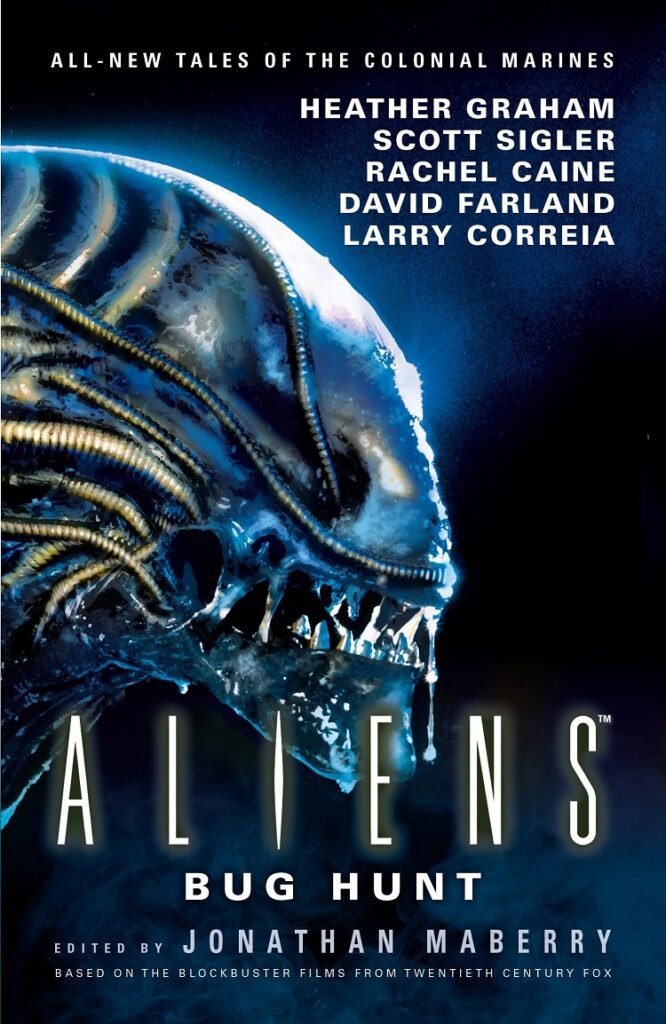
Each film in the original Alien trilogy represents a unique approach to science fiction. Alien took sci-fi and suspense and doubled down on all the terrible rubber-suit space-man movies of yore, giving something that made viewers genuinely squeamish. Aliens set the bar for “guns in space,” a standard that I’m not sure another film has come within shouting distance of since, at least not with the same sense of looming dread — Starship Troopers was laughably satirical and, let’s face it, the Star Wars movies are more about toys and cartoons than dealing with weighty themes or meaningful drama. What about Alien 3? That was a classic example of “You should have just released the Director’s Cut.” So much better than the theatrical release. Each movie has its dedicated fans, and some overlap across franchise outings. If you think the series peaked at “guns in space” and have always wanted more of that, then do we have a treat for you.
Aliens: Bug Hunt is an anthology from Titan Books containing 18 tales of humans sticking their noses — and gun barrels — into nooks and crannies they really ought to leave alone, largely because someone in the ranks at Weyland-Yutani corporation told them to. Better to risk a marine than a suit, right? However, it’s not all military jargon and pulse rifles — although one story extensively details the history and development of the M41A Pulse Rifle in great detail, documentary style. There are other misadventures here featuring mercenaries, security teams, researchers, and some stories simply paint the picture of corporate greed and the grotesqueries of bio-weaponization. The common thread is that they all have the capacity to fight back. Well, except maybe the tale suggesting that corporate sleaze ball Carter Burke was actually dragged back to the hive in Aliens and impregnated, all the while calculating how he could weasel his way out and still collect a fat paycheck from it all.
Several of the stories specifically involve the marines featured in the movie Aliens — Hicks, Hudson, Vasquez, Apone, Frost, Dietrich, Spunkmeyer, and so on. On one hand, it provides some characters with which many of us are already familiar. On the other hand, you know this had to have happened in the 57 years between Alien and Aliens, and that the named folks are going to make it out alive, eliminating some of the suspense. Have you ever wondered what “artificial person” Bishop was up to before he joined the crew of the Sulaco? Maybe you didn’t know that Corporal Dwayne Hicks was married before the events of Aliens, and that his wife seemed to have a lot in common with Ellen Ripley. Shocking, I know. All this and more spans 360 pages, penned by the likes of Dan Abnett, Rachel Caine, Heather Graham, Tim Lebbon, Jonathan Maberry, Yvonne Navarro, and many more.
Stories that didn’t feature any xenomorphs at all were rather refreshing. Seeing how the Colonial Marines handle other alien life-forms that spit fire or explode violently when shot was a curiosity. Makes you wonder why there hasn’t been a spin-off show or movie featuring just that. Perhaps the most interesting of stories for me, though, was written from the perspective of a protector alien, scheming with its brethren to capture more humans from their concrete, towering “hives” to be brought back as hosts. It was a look inside alien behavior and communication and life cycles that virtually never gets examined in the movies, and hasn’t often been explored in other books. It reminded me of the novelization of Predator 2 that featured chapters written from the predator’s perspective, explaining the rules of the hunt, how it perceived different events from the movie, and so forth.
As a writer and editor at heart, I do have to nitpick a couple of things I found within. In one case, Hicks takes shrapnel in his left leg, but a couple of pages later, he’s agonizing over the pain in his right leg. A bounty hunter chasing escaped convicts trying to break into locked-down Hadley’s Hope, while considering her reward, asked for $25M total, half up front, and later speculates about getting the other $5M upon completion. That math doesn’t fly. In another story, as she’s trying to shake a pursuer, “Ripley’s tail” is written as “Ridley’s tale.” Even on the back cover, the summary boasts “15 all-new stories” when, in fact, the book contains 18 stories. Were three of them not new, or were they not technically “bug hunts” in a book literally called Bug Hunt? None of these sinks the ship by any means, but I was surprised how many little hiccups like these survived all the way to print.
As a long-time alien fiend, I enjoyed the stories in this collection, though having a common thread throughout does give a number of tales a bit of a samey feel at their core; whether that familiarity is a good or bad thing depends on what you want to get out of the experience. Given that the average story here is about 20 pages, there isn’t a ton of room to take big chances in storytelling. However, if you’ve been thinking about diving into Alien novels and aren’t sure where to start, this is a good sampler platter to get you started before launching into crazier ideas like narcotics extracted from alien blood, invading an alien homeworld, and the bugs forging a hive here on Earth. About the only way they could make it a more appealing package is if Sigourney Weaver reads the audiobook version.